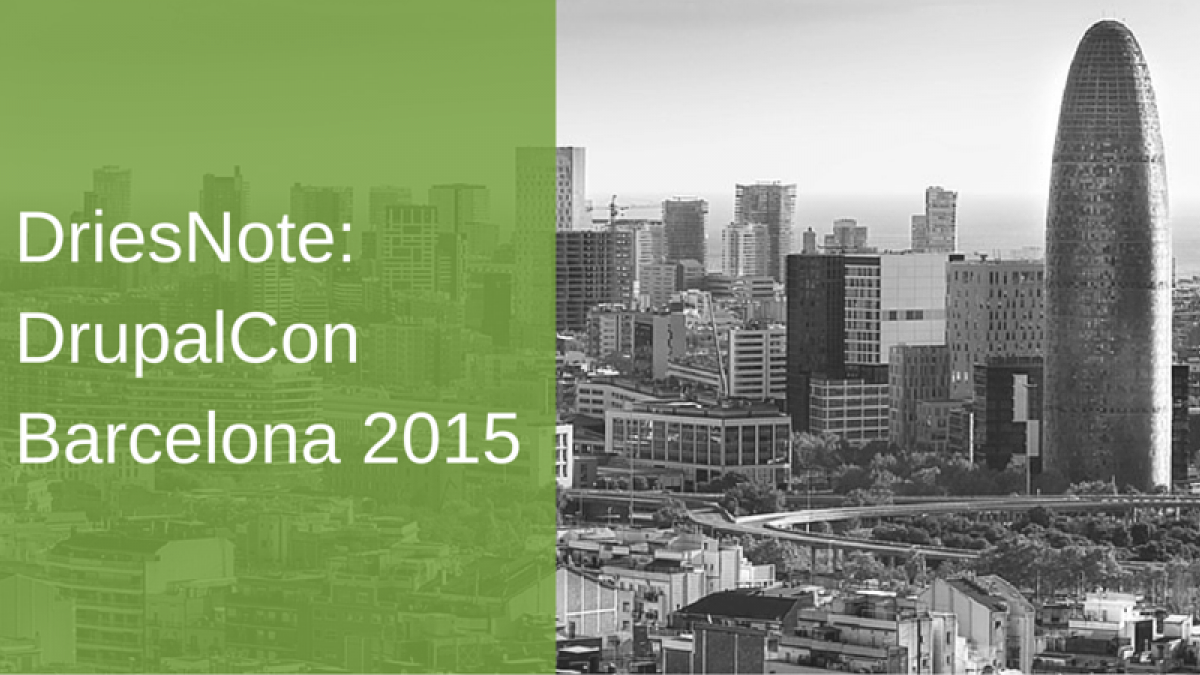
DriesNote: DrupalCon Barcelona 2015
Dries Buytaert, founder of Drupal, gave a keynote address at DrupalCon in Barcelona on September 22, 2015. He answered what he called “three uncomfortable questions” about the state and future of Drupal, and announced that the long-awaited release of Drupal 8 is imminent, planned for October 7, 2015. The speech is available online, however, we've made it easier on you, with the following summary notes on DriesNote:
Is Drupal losing momentum?
Basically, yes, but it will get it back. Users are waiting for the release of Drupal 8, as it has been 5 years since the release of Drupal 7.
- The Obsborne Effect: the announcement of a coming new release slows adoption of the current version. When the new release comes out, a significant spike is expected, as occurred when Drupal 7 was released in 2010.
- Release of Drupal 8 has taken years longer than expected due to work simply not going as planned. Unplanned and abandoned work slows the process. Dries stated, “We can only go as fast as our slowest feature.”
- Drupal 8 is getting more stable with 15,000+ patches contributed by 3,000+ contributors, and 1,300+ critical bugs resolved. The last feature to complete is Twig, so Drupal 8 release is planned for October 7, if no new critical issues are discovered.
“We will fix the way we work.”
-
Create feature branches, and break-up feature branches.
-
Only merge branches when they are shippable, so that the main branch is always shippable.
-
Date-based releases will enable Drupal to be released even if every feature is not ready. Features and patches can be added into later releases.
-
Cross-functional teams improve continuity and follow-through.
-
Core committers and leadership will take on the role of orchestrating and prioritizing merges.
Can Drupal compete?
Yes! People are concerned with growth and feature development of WordPress. However, Drupal and WordPress can’t be compared, as they serve different audiences. There are also many other rising competitors.
- Drupal is dominant for larger, more complex websites.
- Drupal is advanced in its ability to scale and content modeling tools.
- Drupal focuses on the developer.
- To improve the User Experience (UX), Drupal needs to:
-
Focus on the non-coders: builders, authors, and editors.
-
Improve the UX, making it easier to use and more seamless.
-
Let people test the UX throughout the development process, at several points prior to release.
-
Focus on the 80% of the world that does not use a content management system, and convince them that Drupal is right for them.
“We’re in a good position, but we still need to get better at UX. If we do, there’s a big upside.”
Is Drupal technologically relevant?
Are frameworks a threat, and how should Drupal respond to them?
- With traditional CMS (Drupal) a UI provides content to the server, which builds the layout, adds the content, and sends it to the client. Advantages of traditional CMS include:
- Editorial tools, such as toolbar, preview, page layout, and edit-in-place.
- Faster performance with BigPipe.
- With client-side apps (Backbone.js, AngularJS, React, Ember) which are gaining popularity, decoupling occurs, so the app renders the layout and requests content from the server. Advantages of client-side apps include:
- Optimistic feedback.
- Non-blocking user interfaces.
- Application-like experience.
- Progressive decoupling (which will be a part of Drupal 8) can achieve the advantages of both traditional CMS and client-side apps.
- Drupal sends the layout and maintains layout tools.
- Drupal bundles some of the more cacheable content with the layout, sending the fast content first.
- The app requests more content.
Drupal 8 offers the options of traditional, progressive decoupling through page-building tools, and decoupled by feeding Drupal data to client-side apps.
Problem: REST APIs in Drupal 8 require multiple round-trips, and developers lack control over the amount of data collected, resulting in a poor developer experience.
Solution in-progress: GraphiQL, an alternative to REST, allows one API call for only the specific data desired. This results in a better developer experience for query building.
Progressive decoupling and GraphiQL put Drupal ahead of competitors.
Takeaways:
- Drupal 8 needs to be released, and momentum will come.
- Drupal needs to move to a more sustainable development and release process.
- Drupal needs to put non-coders first to increase impact.
- Drupal will be the go-to platform for sites and apps.
What did you think of Dries Buytaert’s talk? What do you think about the changes coming with Drupal 8? What features do you hope to see developed?

